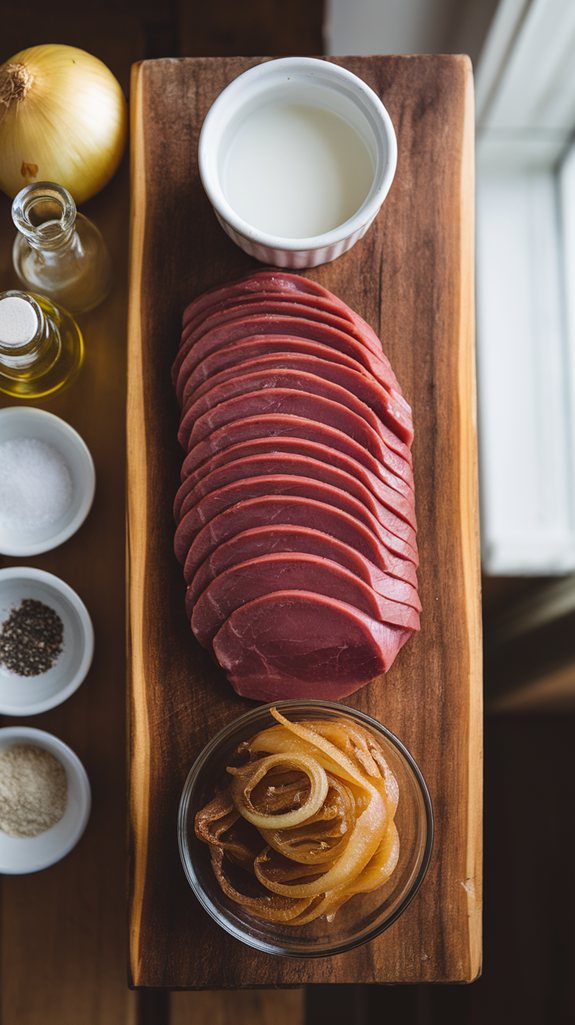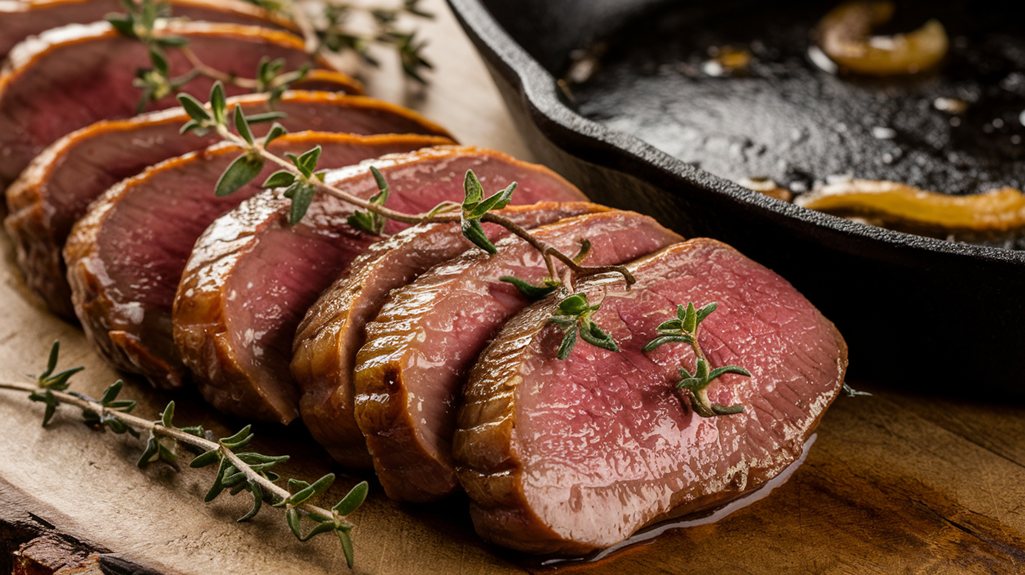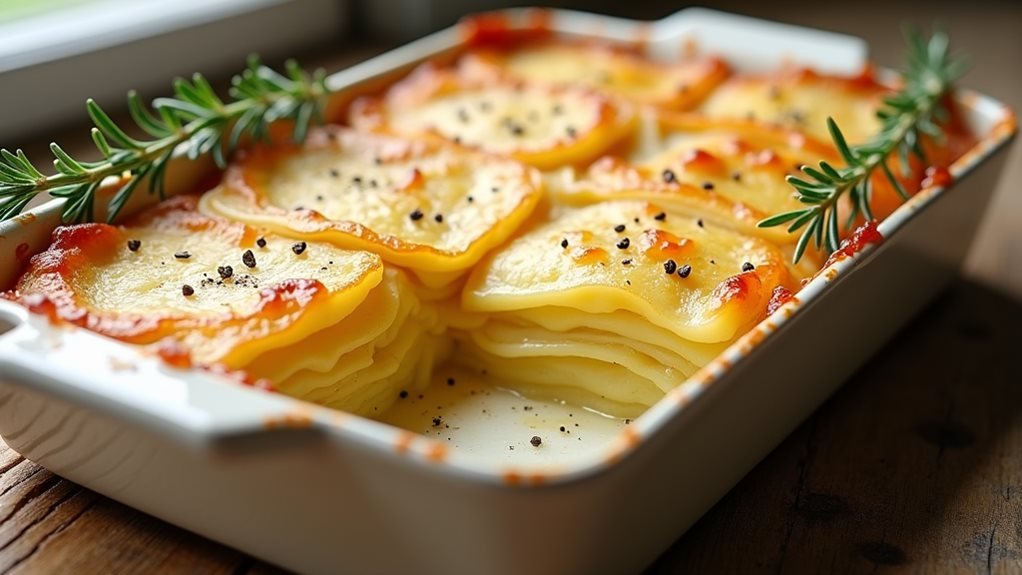Like a master artist transforming raw marble into sculpture, you'll uncover how Gordon Ramsay enhances humble beef liver into a culinary masterpiece. You don't need fancy equipment or hard-to-find ingredients to recreate his signature dish – just attention to detail and proper technique. While many home cooks shy away from liver, Ramsay's method removes the gamey taste and guarantees tender, flavorful results that'll make you reconsider this nutritious cut.
Origins in Victorian England
Three key influences from Victorian England shaped Gordon Ramsay's modern take on beef liver.
Firstly, you'll notice how working-class families made classic liver recipes a staple during the 1800s, perfecting the art of tenderizing this affordable cut.
Subsequently, Victorian butcher shops developed specific slicing techniques that you'll still see in today's preparation methods, ensuring the liver cooks evenly and remains tender.
Lastly, the era's emerging gourmet offal dishes influenced the refined presentation style you'll find in Ramsay's version.
The Victorian practice of marinating liver in milk or buttermilk remains crucial to Ramsay's recipe, as it helps remove any bitter taste.
Much like the German knife craftsmanship that revolutionized kitchen tools, these preparation methods set new standards for culinary excellence.
Like his famous steaks, achieving the perfect temperature before cooking helps ensure room temperature benefits throughout the liver.
You'll appreciate how this traditional method, combined with precise cooking times, creates a dish that honors its humble origins while delivering restaurant-quality results.
This attention to detail and timing mirrors the challenges found in preparing Beef Wellington, which requires perfect execution at every step.
Traditional English Offal Classic

Traditional English offal cuisine takes a delicious turn with Gordon Ramsay's interpretation of beef liver, a dish that has graced British tables for generations. This classic preparation method transforms what was once considered a humble cut into a sophisticated meal worthy of any modern dining table.
The key to this dish lies in the buttermilk marinade, which helps remove any bitter flavors while tenderizing the meat. When paired with caramelized onions, the liver develops a rich, complex flavor profile that exemplifies the best of traditional English cooking. Like his famous Beef Wellington technique, the careful preparation and timing are essential for achieving the perfect result. The dish pairs beautifully with creamy fricassée sauce for an elegant touch, and can be complemented with Alfredo sauce for added richness.
- 12 ounces beef liver, sliced
- 1 cup buttermilk
- 1 yellow onion, thinly sliced
- 2 tablespoons olive oil
- ½ teaspoon garlic powder
- Black pepper to taste
- Sea salt to taste
Begin by soaking the liver slices in buttermilk for at least one hour. Remove the liver from the marinade and pat dry with paper towels. Season with garlic powder, salt, and pepper.
Heat 1 tablespoon of olive oil in a large skillet over medium heat and cook the onions until caramelized, about 10-12 minutes. Remove onions and set aside. In the same pan, add remaining oil and sear the liver for 2-3 minutes per side until golden brown but still slightly pink inside. Return the onions to the pan, warm through, and serve immediately.
For best results, verify the liver is at room temperature before cooking and avoid overcrowding the pan, as this will prevent proper searing. The liver should be sliced to an even thickness of about ½ inch to guarantee consistent cooking.
Never cook liver beyond medium-rare, as it will become tough and lose its delicate flavor. If serving to those new to liver, consider cutting the slices smaller and verifying they're very thin to make the texture more appealing.
Modern Mediterranean Style
While Gordon Ramsay's beef liver recipe has English roots, his Mediterranean interpretation brings bright, fresh flavors to this classic dish. You'll find this version incorporates olive oil, fresh herbs, and garlic, transforming traditional savory liver dishes into something lighter and more vibrant.
To create this rich meat dish Mediterranean-style, you'll want to marinate your liver in buttermilk infused with fresh rosemary and thyme. After cooking, drizzle with extra virgin olive oil and a squeeze of lemon juice. The addition of capers and fresh parsley adds a Mediterranean touch that brightens the dish considerably. The liver pairs wonderfully with truffle oil for an extra layer of luxurious flavor. The careful stirring technique used in his famous risotto recipes can be applied when making the sauce for this liver dish.
Gordon Ramsay's beef liver recipe works beautifully with Mediterranean sides like roasted cherry tomatoes and garlic-sautéed spinach, creating a balanced plate that's both nourishing and delicious. The dish pairs perfectly with his perfect holiday gravy, made by whisking flour into melted butter and gradually adding broth until thickened.
Seasoning Before Searing Tips
Getting the seasoning right before searing your beef liver makes all the difference in achieving restaurant-quality results.
After you've marinated the liver in buttermilk and patted it dry, you'll want to season it generously with Gordon Ramsay's recommended blend of sea salt, black pepper, and garlic powder.
For best results, sprinkle the seasonings evenly on both sides of your liver slices about 5 minutes before they hit the pan. This timing allows the seasonings to adhere properly without drawing out excess moisture.
Don't forget to press the seasonings gently into the meat with your fingertips – this helps create that perfect crust when searing.
Ensuring your pan is properly heated first will help you achieve that delicious brown crust while sealing in the juices.
Preserving Tenderness After Cooking
Once you've achieved that perfect sear on your beef liver, maintaining its tenderness becomes crucial for the best dining experience.
After cooking, let your liver rest for 3-5 minutes before slicing to help retain its juices and preserve the benefits of your earlier marination.
If you're not serving immediately, cover the beef liver loosely with foil to keep it warm while maintaining its texture.
When storing leftovers, slice the liver only when you're ready to eat it, as pre-slicing can lead to moisture loss.
Keep in mind that reheating should be gentle – use low heat and avoid overcooking, which can toughen the meat.
For the best results, bring refrigerated liver to room temperature for 15 minutes before reheating, and add a small pat of butter to restore moisture and tenderness.
Quick-Prep Liver Notes
Beyond storing your cooked liver properly, you'll want some handy tips for quick preparation when time's running short.
For a speedy gourmet beef liver dish, slice your liver while it's still partially frozen – it's easier to cut and maintains its shape better. You can also prep your seasonings ahead of time by mixing garlic powder, salt, and pepper in a small container.
When you're ready to cook, have your butter measured and your pan preheated. This saves precious minutes and guarantees even cooking.
If you've forgotten to marinate the liver in buttermilk, a quick 30-minute soak will still help tenderize it.
Keep your onions pre-sliced in an airtight container in the fridge, ready to caramelize at a moment's notice.







